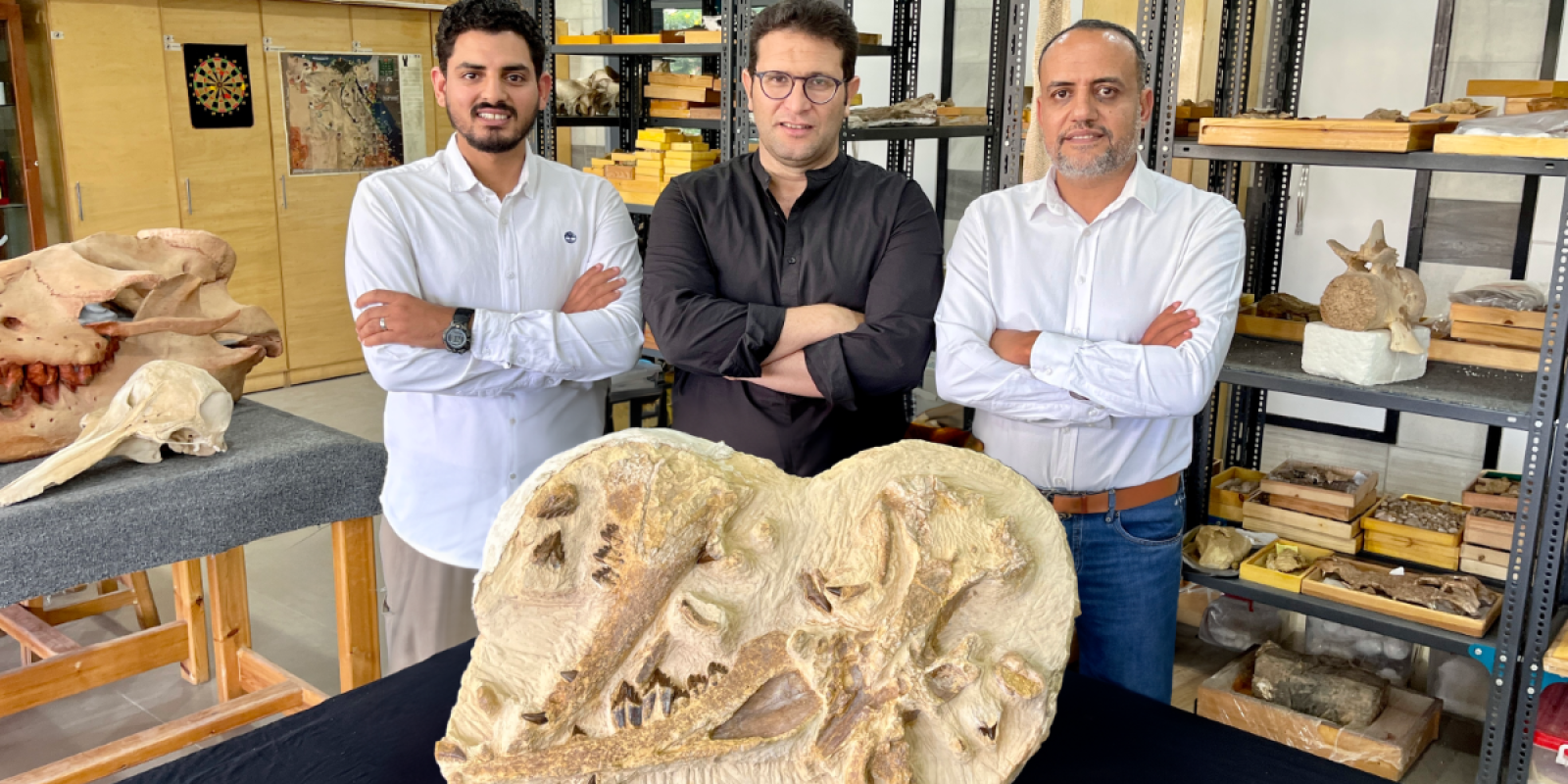
AUC Professor Hesham Sallam Leads the Discovery of a New Species of an Extinct Whale Tutcetus That Died Young 41 Million Years Ago
Hesham Sallam, professor of vertebrate paleontology at The American University in Cairo (AUC) and founder of Mansoura University Vertebrate Paleontology Center (MUVP) led a team of international scientists and Egyptian researchers to a groundbreaking discovery of a new species of extinct whale,Tutcetus rayanensis, that inhabited the ancient sea covering present-day Egypt around 41 millionyears ago. This new whale is the smallest basilosaurid whale known to date and one of the oldest records of that family from Africa. Despite its tiny size, Tutcetus has provided unprecedented insights into the life history, phylogeny, and paleobiogeography of early whales. The team's findings have been published today in Communications Biology, an open-access journal from Nature Portfolio publishing high-quality research, reviews and commentary in all areas of the biological sciences.
The name of the new whale draws inspiration from Egyptian history and the discovery’s locale. Tutcetus combines "Tut" – referring to the famous adolescent Egyptian Pharaoh Tutankhamun – and "cetus," Greek for whale, highlighting the specimen's small size and young age. Rayanensis refers to the Wadi El-Rayan Protected Area in Fayoum, where the whale was found. Additionally, the name was chosen to commemorate the centennial of the discovery of King Tut’s tomb and coincides with the impending opening of the Grand Egyptian Museum in Giza.
According to Sallam, Basilosauridae (a group of extinct fully aquatic whales) represents a crucial stage in whale evolution as they transitioned from land to sea. “They developed fish-like characteristics, such as a streamlined body,a strong tail, flippers, and a tail fin, and had the last hind limbs visibleenough to be recognized as ‘legs,’ which were not used for walking but possibly for mating,” he noted.
Sallam added that "Whales’ evolution from land-dwelling animals to beautiful marine creatures embodies the marvelous adventurous journey of life. “Tutcetus is a remarkable discovery that documents one of the first phases of the transition to a fully aquatic lifestyle that took place in that journey.”
The study shows that the holotype specimen consists of a skull, jaws, hyoid bone, and the atlas vertebra of a small-sized subadult basilosaurid whale which is embedded in an intensively compacted limestone block. With an estimated length of 2.5 meters and a body mass of approximately 187 kilograms, Tutcetus is the smallest known basilosaurid to date.
The study’s lead author, Mohamed Antar, from MUVP and the National Focal Point for Natural Heritage, said that Tutcetus significantly broadens the size range of basilosaurid whales and reveals considerable disparity among whales during the middle Eocene period. “The investigation of the older layers in Fayoum layersmay reveal the existence of an older assemblage of early whale fossils, potentially influencing our current knowledge of the development of whales,” he said.
Through detailed analyses of Tutcetus's teeth and bones, using CT scanning, the team was able to reconstruct the growth and development pattern of this species, providing an unparalleled understanding of the life history of early whales. The rapid dental development and small size of Tutcetus suggest a precocial lifestyle with a fast pace of life history for early whales. Additionally, the discovery of Tutcetus contributes to the understanding of the basilosaurids' early success in the aquatic environment, their capacity to outcompete amphibious stem whales, and their ability to opportunistically adapt to new nichesafter severing their ties to the land.The team's findingssuggest that this transition likely occurred in the (sub)tropics.
Abdullah Gohar, a PhD student at Mansoura University and a memberof Sallam Lab and a co-author of the study, said: “Modern whales migrate to warmer, shallow waters for breeding and reproduction, mirroring the conditions found in Egypt 41 million years ago. This supports the idea that what is known as now Fayoumwas a crucial breeding area for ancientwhales, possibly attracting them from various locations and, in turn, drawing in larger predatory whales like Basilosaurus”.
The team's findings have significant paleobiogeographic implications, demonstrating that basilosaurids likely achieved a rapid spread over the Southern Hemisphere, reaching high latitudes by the middle Eocene.
According to Erik Seiffert,chair and professor of Integrative Anatomical Sciences at the University of Southern California and a co-author of the study, the Eocene fossil sites of Egypt’s Western Desert have long been the world’s most important for understanding the early evolution of whales and their transition to a fully aquatic existence. “The discovery of Tutcetus demonstrates that this region still has so much more to tell us about the fascinating story of whale evolution,” he said.